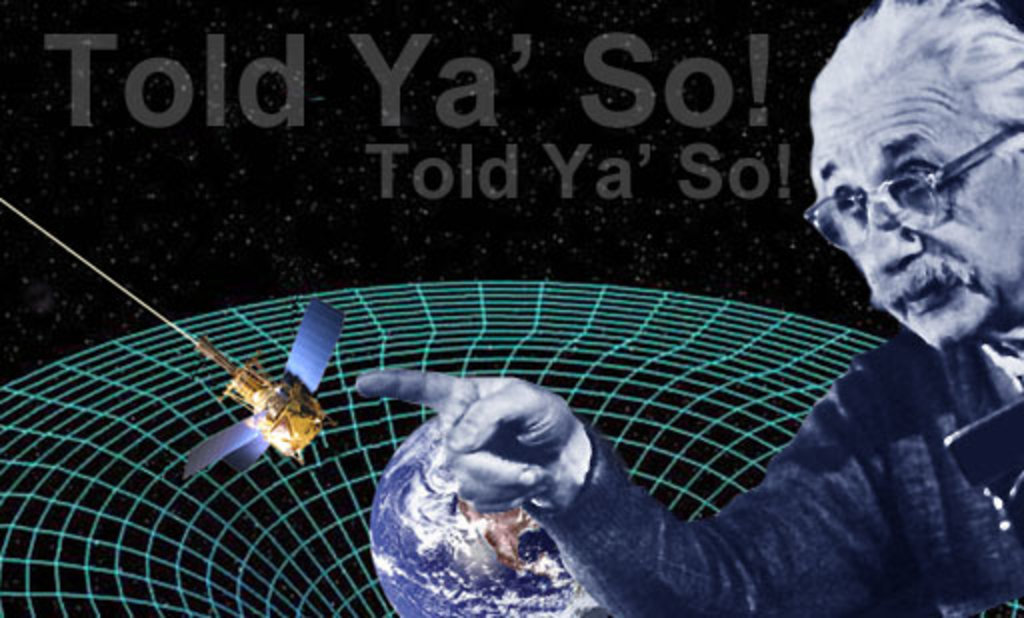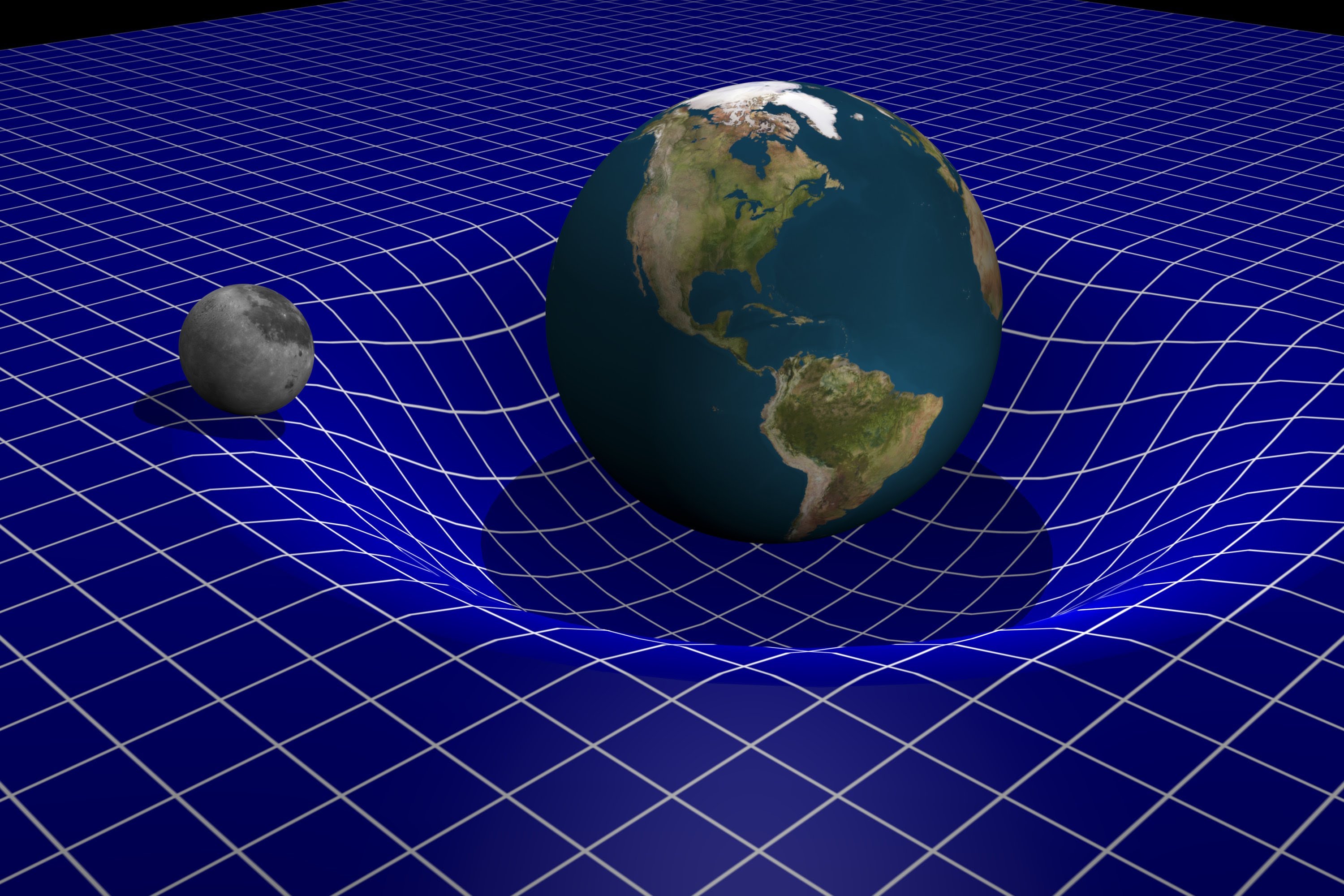
Albert Einstein may have been the genius among physicists, but like all others before his time, he stood on the shoulders of giants.
Einstein did not propose that the sun was the center of the solar system; that idea was already widely accepted when he came around. He didn’t discover elliptical orbits; that distinction belongs with Johannes Kepler.
But Kepler never could figure out why planets orbit the sun in ellipses instead of circles. Even Isaac Newton, who at last identified gravity as the reason we stick to Earth’s surface, couldn’t explain what gravity was—only how it worked.
Einstein provided that explanation with his general theory of relativity.
The general theory of relativity is related to special relativity in that they’re both about velocity (speed with direction) being relative.
Special relativity basically states that you can’t measure your speed except against another object. For example, we measure highway speeds against the Earth, which we pretend for the moment isn’t moving beneath us.
Once you remember that we’re actually riding the Earth as it whizzes about the sun at 108,000 kph, it’s easy to grasp special relativity.
But special relativity earns its name—it’s special. And it only refers to objects that aren’t being accelerated.
Hold on a second…accelerated? What does that mean?
The physics definition of acceleration is absolutely any change in velocity. That could mean speeding up, slowing down, or even changing direction.
A change in any one of those things is easy to feel. It’s why the coffee in your mug sloshes when you pick it up. It’s also why cars can’t take turns quickly and take longer to slow the faster they’re going.
What does all this have to do with relativity?
Well, imagine you’re in an elevator.

Have you ever noticed that when the elevator moves upward, you feel heavier? Your feet press that much harder into the floor. The effect is gone in just a second, but when the elevator first accelerates, your weight seems to increase.
It doesn’t. I’ll let you in on a secret. Your weight is a secret that only your mass and gravity knows. Nothing else even cares about your weight, and certainly not your elevator.
What’s happening is the elevator is accelerating upward, and your mass doesn’t like that. Because mass has inertia, it likes to stay moving exactly how it is. If that means not moving, then so be it. So it resists. It tries to press the elevator right back.
Obviously, the elevator wins out, and you go up. Once your mass is moving the speed of the elevator, it decides that it likes that speed and wants to stay that way forever—that’s inertia again. So when the elevator slows and stops, you actually feel lighter for a moment.
It’s the same thing that happens if you take the elevator down, and you feel lighter for a moment before your mass decides it likes the elevator’s speed. And when you stop moving, you feel heavier for a moment as your feet press into the floor.
Einstein recognized that riding in an accelerating rocket would feel the same way.

If your rocket’s engines are on, you know you’re accelerating because all your instruments say so. But you don’t need to look at your instruments to know, because you’re mass, you have inertia, and you’ll feel it.
If you’re accelerating at 9.8 m/s2 (meters per second), then you’ll feel like you’re standing on Earth’s surface.
Why? Because Earth’s gravity makes anything at the surface accelerate downward at 9.8 m/s2.
And if you feel any other acceleration—10 m/s2, 20 m/s2, anything—you’ll feel as if you’re on a planet whose acceleration due to gravity is that same speed. In short, if you’re accelerating through space, you’ll feel gravity.
Einstein took this a step forward and suggested that gravity, inertia, and acceleration are all related. And not only that, they’re associated with the way space is related to time.
Huh?
Yeah…that idea is just whacky. I mean, since when is space related to time? We can move forward in space and control that motion, but time moves against our bidding. We can move backwards in space, but we sure can’t move backwards in time.
Or can we?

This part of relativity isn’t actually part of general relativity, but it feeds into my argument. How can a space traveler return home younger than his twin if time didn’t slow down for one of them?
I know that’s an absolutely whacky idea. But it’s been investigated—though not by me—and is actually a leading theory. And it’s an example of how space must be related to time. After all, the only distance the traveler purposefully crossed is space.
Anyway…I digress. Einstein’s theory of general relativity simply says that, in short, mass tells space-time how to curve, and the curvature of space-time tells mass how to accelerate.
Okay…wow. What does that mean?
Ever seen this scientific model before?

Maybe you have, maybe you haven’t. This is the explanation Einstein proposed for gravity.
What you’re seeing is an illustration of how the Earth’s presence actually deforms the space around it, like sitting on a trampoline. You can imagine space-time as one giant trampoline, and the moon as a marble that rolls toward the dip the Earth makes.
The moon doesn’t actually roll…it keeps the same side facing us at all times. But the concept is the same.
Now, general relativity is a bit more than that—space, as you know, isn’t two-dimensional. It’s not a big, flat trampoline. If it were, then we couldn’t get images like this, because every galaxy there was would sit flat on the same plane as our solar system.

Space-time is, in fact, not even three-dimensional. It’s four-dimensional. Because there are already three dimensions of space, and there has to be a fourth for time.
If that doesn’t blow your mind, I don’t know what will. Don’t worry, I don’t get it either. I just know it’s true, and as soon as I figure it out, I’ll let you know how it works.
Space is four-dimensional, so you have to try to imagine a trampoline that extends all around you—not just to your sides, but above and below you. And any marble remotely in the vicinity, up, down, left, right, front, or back, will move toward you.
Oh, and did I forget to mention that it’ll move through time as well?
Yeah…that’s the whole twin paradox thing again. The space traveler will move more slowly through time for some reason, whereas the twin on Earth will age as “usual.”
And I put “usual” in quotes because how can we call the time we experience on one planet in the universe “usual”? For all we know, time runs twice as fast over on one of the planets orbiting the star Proxima Centauri.
Anyway, you get the picture. That’s general relativity for you. And tomorrow, I’ll be talking about how we know this is true. Einstein is a genius, sure, but that doesn’t explain why anyone believed him. Scientists need proof—they can’t just trust.